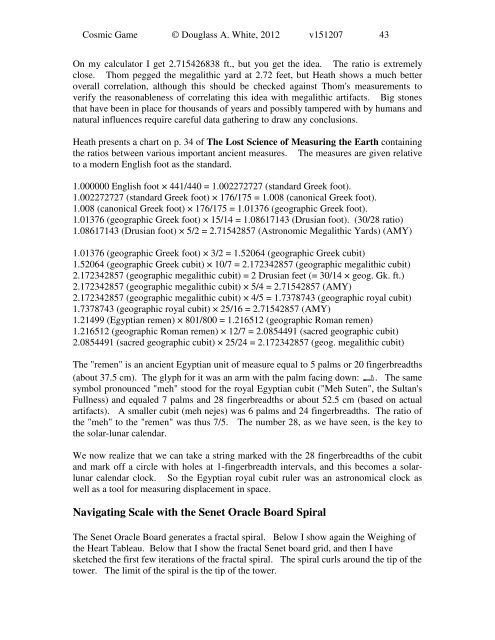Create successful ePaper yourself
Turn your PDF publications into a flip-book with our unique Google optimized e-Paper software.
<strong>Cosmic</strong> <strong>Game</strong> © Douglass A. White, 2012 v151207 43<br />
On my calculator I get 2.715426838 ft., but you get the idea. <strong>The</strong> ratio is extremely<br />
close. Thom pegged the megalithic yard at 2.72 feet, but Heath shows a much better<br />
overall correlation, although this should be checked against Thom's measurements to<br />
verify the reasonableness of correlating this idea with megalithic artifacts. Big stones<br />
that have been in place for thousands of years and possibly tampered with by humans and<br />
natural influences require careful data gathering to draw any conclusions.<br />
Heath presents a chart on p. 34 of <strong>The</strong> Lost Science of Measuring the Earth containing<br />
the ratios between various important ancient measures. <strong>The</strong> measures are given relative<br />
to a modern English foot as the standard.<br />
1.000000 English foot × 441/440 = 1.002272727 (standard Greek foot).<br />
1.002272727 (standard Greek foot) × 176/175 = 1.008 (canonical Greek foot).<br />
1.008 (canonical Greek foot) × 176/175 = 1.01376 (geographic Greek foot).<br />
1.01376 (geographic Greek foot) × 15/14 = 1.08617143 (Drusian foot). (30/28 ratio)<br />
1.08617143 (Drusian foot) × 5/2 = 2.71542857 (Astronomic Megalithic Yards) (AMY)<br />
1.01376 (geographic Greek foot) × 3/2 = 1.52064 (geographic Greek cubit)<br />
1.52064 (geographic Greek cubit) × 10/7 = 2.172342857 (geographic megalithic cubit)<br />
2.172342857 (geographic megalithic cubit) = 2 Drusian feet (= 30/14 × geog. Gk. ft.)<br />
2.172342857 (geographic megalithic cubit) × 5/4 = 2.71542857 (AMY)<br />
2.172342857 (geographic megalithic cubit) × 4/5 = 1.7378743 (geographic royal cubit)<br />
1.7378743 (geographic royal cubit) × 25/16 = 2.71542857 (AMY)<br />
1.21499 (Egyptian remen) × 801/800 = 1.216512 (geographic Roman remen)<br />
1.216512 (geographic Roman remen) × 12/7 = 2.0854491 (sacred geographic cubit)<br />
2.0854491 (sacred geographic cubit) × 25/24 = 2.172342857 (geog. megalithic cubit)<br />
<strong>The</strong> "remen" is an ancient Egyptian unit of measure equal to 5 palms or 20 fingerbreadths<br />
(about 37.5 cm). <strong>The</strong> glyph for it was an arm with the palm facing down: +. <strong>The</strong> same<br />
symbol pronounced "meh" stood for the royal Egyptian cubit ("Meh Suten", the Sultan's<br />
Fullness) and equaled 7 palms and 28 fingerbreadths or about 52.5 cm (based on actual<br />
artifacts). A smaller cubit (meh nejes) was 6 palms and 24 fingerbreadths. <strong>The</strong> ratio of<br />
the "meh" to the "remen" was thus 7/5. <strong>The</strong> number 28, as we have seen, is the key to<br />
the solar-lunar calendar.<br />
We now realize that we can take a string marked with the 28 fingerbreadths of the cubit<br />
and mark off a circle with holes at 1-fingerbreadth intervals, and this be<strong>com</strong>es a solarlunar<br />
calendar clock. So the Egyptian royal cubit ruler was an astronomical clock as<br />
well as a tool for measuring displacement in space.<br />
Navigating Scale with the Senet Oracle Board Spiral<br />
<strong>The</strong> Senet Oracle Board generates a fractal spiral. Below I show again the Weighing of<br />
the Heart Tableau. Below that I show the fractal Senet board grid, and then I have<br />
sketched the first few iterations of the fractal spiral. <strong>The</strong> spiral curls around the tip of the<br />
tower. <strong>The</strong> limit of the spiral is the tip of the tower.





